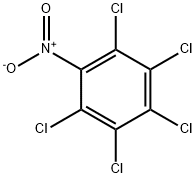펜타클로로니트로벤젠 C화학적 특성, 용도, 생산
개요
Pentachloronitrobenzene (PCNB) is a pesticide and
fungicide. Sensitization can occur in farmers and in
those working in chemical plants.
화학적 성질
Light green powder
용도
Fungicide for seed and soil treatment.
생산 방법
Quintozine is produced by nitration of pentachlorobenzene.
정의
ChEBI: A C-nitro compound that is nitrobenzene in which every hydrogen has been replaced by a chlorine. A fungicide used on a variety of crops, including cotton, rice and seed grains, it is no longer approved for use within the European Union.
일반 설명
Crystalline pale yellow to white solid or powder with a musty moth ball odor. Insoluble in water and denser than water. Hence sinks in water.
공기와 물의 반응
Insoluble in water.
반응 프로필
Quintozine is hydrolyzed by alkalis. Is incompatible with strong oxidizing agnets. Also incompatible with strong bases. Corrosive to unlined metal containers .
건강위험
Exposures to quinalphos cause toxicity and adverse health effects. On contact with the
skin, quinalphos causes the effects of sensitization.
화재위험
On hazardous decomposition, quintozene releases phosgene, hydrogen chloride, oxides of nitrogen, and chlorine-containing compounds, and other unknown materials may be released in a fire situation. Incomplete combustion may lead to the formation of oxides of carbon.
농업용
Soil fungicide, Nematicide, Seed treatment: Quintozene, the common name for PCNB or pentachlkoronitrobenzene, is an organochlorine fungicide used as a seed dressing or soil treatment to control a wide range of fungi species in such crops as potatoes, wheat, onions, lettuce, tomatoes, tulips, garlic, and others. Depending on the producer and the manufacturing procedure, PCNB impurities can include hexachlorobenzene, pentachlorobenzene, and tetrachloronitrobenzene. The fungicide is often used in combination with insecticides and fungicides including carbaryl, imazalil, tridimenol, etridiazole, and fuberidazole. It is available as a dustable or wettable powder, in granular form, emulsifiable concentrate, and seed treatment. Not approved for use in EU countries. Registered for use in the U.S. and Canada. There are more than 35 global suppliers.
상품명
(EPA lists 290 active and canceled or transferred products) AVICOL (PESTICIDE)®; BOTRILEX®; BLOCKER 4F®; BOTRILEX®; BRASSICOL®; BRASSICOL EARTHCIDE®; BRASSICOL 75®; BRASSICOL SUPER®; CHINOZAN®; EARTHCIDE®; FARTOX®; FOLOSAN®; FOMAC 2®; FUNGICHLOR®; GC 3944-3-4®; KOBU®; KOBUTOL®; KODIAK A-T FUNGICIDE®; KP 2®; MARISAN FORTE®; MEFENOXAM®; PARFLO®; PENTAGEN®; PHOMASAN®; PKhNB®; RTU 1010®; SANICLOR 30®; TERRACHLOR®; TERRACLOR®; TERRACLOR 30G®; TERRA-COAT®; TERRAFUN®; TERRAZAN®; TILCAREX®; TRIPCNB®; TRIQUINTAM®; TRITISAN®; TUBERGRAN®; TURFCIDE®; VITAVAX® Quintozene
색상 색인 번호
Pentachloronitrobenzene is a pesticide and a fungicide.
Sensitization can occur in farmers or in chemical plants.
Safety Profile
Moderately toxic by ingestion. An experimental teratogen. Questionable carcinogen with experimental carcinogenic data. Mutation data reported. Used as a fungcide. Dangerous; when heated to decomposition it emits highly toxic fumes of NO, and Cl-. See also NITRO COMPOUNDS OF AROMATIC HYDROCARBONS
잠재적 노출
Those engaged in manufacture, formulation
and application of this soil fungicide and seed treatment
chemical. Peracetic acid is often used as a sterilizing
agent in the medical, food service and pharmaceutical industries
in combination hydrogen peroxide and acetic acid.
환경귀착
Biological. Pentachloronitrobenzene is rapidly degraded in flooded soils forming pentachloroaniline. When pentachloronitrobenzene was incubated in a submerged soil and
moist soil for 3 weeks, the percentages of the applied dosage remaining were <1 and 82%,
respectively. Chacko et al. (1966) reported microorganisms can convert pentachloronitrobenzene to pentachloroaniline and pentachlorothioanisole
Soil. The half-lives of pentachloronitrobenzene in a Columbia fine sandy loam, Sacramento clay and Staten peaty muck from California were 4.7, 7.6 and 9.7 months,
respectively. Degradation products were pentachloroaniline and pentachlorothioanis
When heated to decomposition (330°C), emits toxic fumes of nitrogen oxides and
chlorine (Sax and Lewis, 1987)
신진 대사 경로
Renner (1981) has reviewed the metabolism of quintozene. Fate in soil,
plants, several animal species and fish has been reported. The nitro group
provides a reactive centre, which allows rapid metabolism via three
primary routes: nitro reduction, glutathione-dependent denitration and
dechlorination. Thus a very complex array of metabolites is formed.
Quintozene is relatively persistent in soil in comparison with plants
and animals. It was one of the compounds which stimulated the study
and understanding of the catabolism of glutathione conjugates in
plants and animals and this was properly elucidated for the first
time using such compounds. Nitro reduction and nitro displacement is
quite rapid and therefore quintozene is much less persistent than is
hexachlorobenzene. The latter shares one of the primary metabolites
[ S-(pentachlorophenyl)glutathione] with quintozene and many of the
sulfur-containing metabolites are common to both compounds.
운송 방법
UN3077 Environmentally hazardous substances,
solid, n.o.s., Hazard class: 9; Labels: 9-Miscellaneous
hazardous material, Technical Name Required. UN2811 Toxic solids, organic, n.o.s., Hazard Class: 6.1; Labels:
6.1-Poisonous materials, Technical Name Required.
Purification Methods
Crystallise it from EtOH. [Beilstein 5 H 247, 5 II 188, 5 III 618.]
비 호환성
Incompatible with oxidizers (chlorates,
nitrates, peroxides, permanganates, perchlorates, chlorine,
bromine, fluorine, etc.); contact may cause fires or explo-
sions. Keep away from alkaline materials, strong bases,
strong acids, oxoacids, epoxides. Thermal decomposition
products may include nitrogen oxides and hydrogen chlo-
ride. Corrosive to unlined metal containers .
폐기물 처리
Dispose of contents/container
to an approved waste disposal plant or consult with envi-
ronmental regulatory agencies for guidance on
acceptable disposal practices. Generators of waste contain-
ing this contaminant (≥100 kg/mo) must conform to EPA
regulations governing storage, transportation, treatment,
and waste disposal. In accordance with 40CFR165, follow
recommendations for the disposal.
펜타클로로니트로벤젠 준비 용품 및 원자재
원자재
준비 용품








